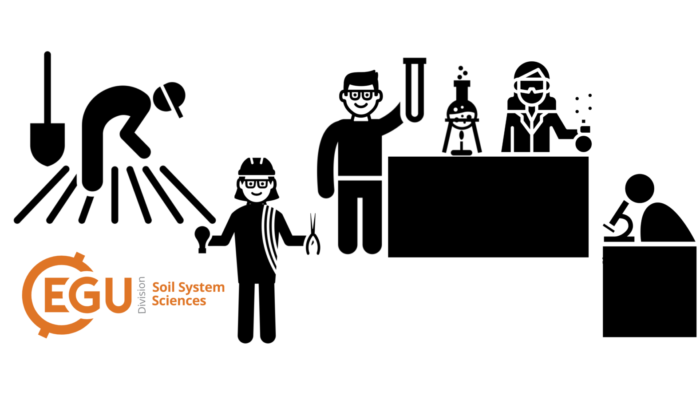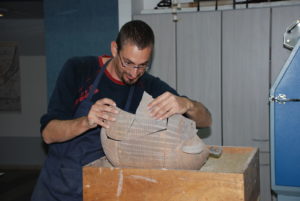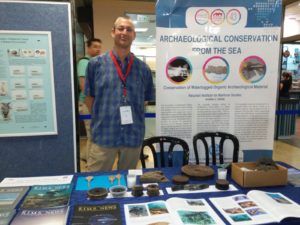
Happy New Year! It’s January, and time for us to continue our monthly series of blog posts dedicated to highlighting the great work carried out by technicians, laboratory assistants, and research support staff in soil science.
This month, we sat down (virtually, of course) with Jonathan J. Gottlieb (J.J.), the Head of the Laboratory for the Conservation of Waterlogged, Organic, Archaeological materials and the Pottery Restoration Lab at the Leon Recanati Institute for Maritime Studies, University of Haifa, Israel. J.J. received his B.A. from University of California, Berkeley, in Classical Archaeology and his M.A. from University of Haifa (Dept. Archaelogy) in Conservation Studies, researching ancient lime-based mortars. Danny Itkin, whose research focuses on pedology of ‘archaeological soils’, has shared with us that J.J. has uniquely contributed to his own understanding of soils throughout his M.A. and PhD studies.
Check out previous editions in this series, including our conversation with Ruma Umari, a Paraecologist in Papua New Guinea, and our chat with Hanka Veselá, a Lab manager and researcher in Prague.
And don’t forget each month, we’ll spotlight a technician in soil science from around the world, and find out a little of their roles and responsibilities behind the scenes. So, if you’re a technician, or if you’d like to nominate a technician for this feature, please email Daniel.L.Evans@cranfield.ac.uk
Technician of the Month #3
Jonathan J. Gottlieb – Recanati Institute for Maritime Studies, University of Haifa, Israel

In the restoration lab, pottery from archaeological excavations is reassembled. Here, Jonathan is assembling a basket-shaped storage jar from the first quarter of the 8th century CE, from the Tantura E shipwreck. Photo credit: JJ Gottlieb.
Hello Jonathan, nice to meet you! Can you start by telling us more about your position and your main responsibilities?
I am the head conservator for the Recanati Institute for Maritime Studies, at the University of Haifa (Israel). In addition to the conservation work and other duties, I assist researchers by making petrographic slides for micromorphological analysis.
What made you want to be a research technician?
I studied archaeology but was always fascinated with the “behind the scene” and the technical aspect of assisting researchers.
What would you say is the most exciting aspect about being a research technician in soil science?
Ever since I was young, I was drawn to geology, rocks and minerals. To observe these on a microscopic level is exciting. As a child, I always collected rocks and minerals from wherever I went. As I grew up, I began to appreciate how these were formed. While studying for my Masters’ degree, I took courses of a more technical nature in geology and soil sciences. In my private life, I am very interested in soil biology in combination with its mineralogy, which lend to the formation of the backbone of life.

In the petrography lab, Jonathan grinds and polishes samples for micromorphological analysis on the diamond cup wheel of the Hillquist thin section machine. Photo credit: JJ Gottlieb.
What would you say is the most challenging aspect of being a research technician?
Technicians’ expertise makes researchers realize their hypotheses. Since we provide a crucial link, it is imperative that we perform our job as best we can. The techniques by which a research technician is given a sample which may be friable, and, using polymers and other materials, transforms it into a specimen that can be analyzed, is challenging. At times, certain materials are not available to the technician. This is where the technician must get creative without compromising the sample or the accurate analysis of the material.
What is the one thing you wish soil scientists would do (or do more) when they work with technicians?
Communication is always important. But in all my years of doing what I do, I haven’t really encountered problems. I would like to believe that the researchers value our skills.

Jonathan’s work not only includes lab work!. Here, he presents organic archaeological objects which his lab was able to conserve, to the Board of Directors of the University of Haifa. Photo credit: JJ Gottlieb.
Is there anything else you would like to share with the soil science community?
I look upon research as a large chain, where all aspects are important links. The knowledge that one cannot work without the other is important to remember. Mutual respect and communication (as mentioned) are important, and the fact that we can all learn from one another. It most definitely helps if the technician has knowledge and interest in the subject. These, I believe, make the job easier and more interesting. I had, and still have, the great fortune to work with pedologists and geologists who were patient and took their time to explain what they were looking for; something that made my assignments more fun because it enriched my knowledge of the subject.
Indeed, researchers may sometimes not fully realize that technicians are interested in the scientific value of what they are working on, too. Thanks for the reminder! Thank you for talking with us and we wish you all the best in 2021 and your future work!
Edited by Danny Itkin, Layla M. San-Emeterio and Olga Vindušková
References
[1] Featured image created by Olga Vindušková using icons created by Louis Prado, Adrien Coquet, ProSymbols, and iconixar, from Noun Project

Morrel
One of the best ways to promote Science in different fields.